It seems that this year we have thoroughly explored the capabilities of MSI motherboards that support the twelfth, thirteenth and fourteenth generation Core chips. Following the reviews of MAG Z790 TOMAHAWK MAX WIFI, MEG Z790 GODLIKE and MPG Z790 EDGE TI MAX WIFI, we invite you to get acquainted with another model with the “High-end” prefix in the name – MEG Z790 ACE MAX.
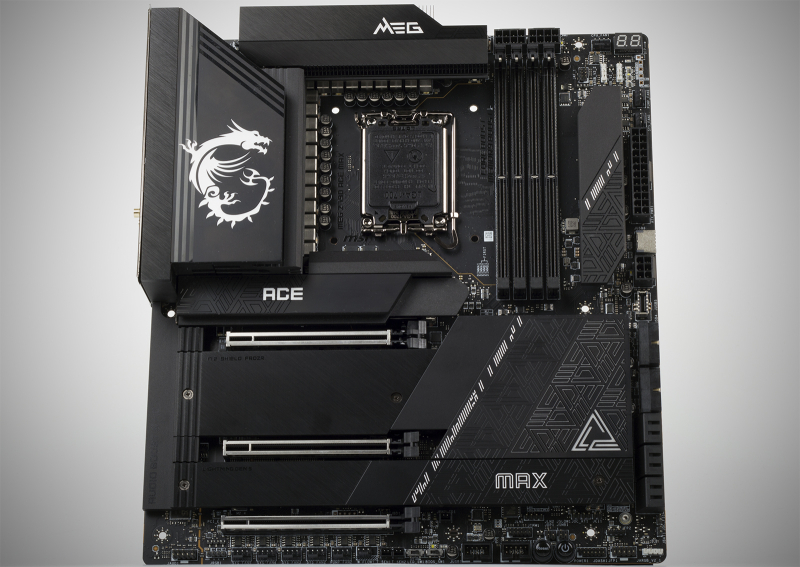
MSI MEG Z790 ACE MAX
⇡#Technical characteristics and equipment
As you know, the MEG series of boards includes the company’s most high-tech products. We are talking about fashion devices suitable for assembling the most advanced PCs. The word “MAX” in the device name indicates the use of the most advanced standards: the maximum version of the MEG Z790 ACE supports PCI Express 5.0 (this applies to both PEG and M.2) and Wi-Fi 7 (aka 802.11be). At the time of writing, better technologies simply did not exist. The list of the main characteristics of the hero of today’s review is shown in the table.
1 × M.2 (Socket 3, 2260/2280/22110, CPU) with PCI Express x4 4.0 support
1 × M.2 (Socket 3, 2260/2280, PCH) with support for PCI Express x4 4.0 and SATA 6 Gb/s
1 × M.2 (Socket 3, 2260/2280/22110, PCH) with support for PCI Express x4 4.0 and SATA 6 Gb/s
1 × M.2 (Socket 3, 2260/2280, PCH) with PCI Express x4 4.0 support
1 × RGB LED
3 × ARGB LED
1 × F-Audio
2 × USB 2.0
2 × USB 3.2 Gen1
2 × USB 3.2 Gen2x2
Additionally:
1 × Water Flow
1 × case opening sensor
2 × thermocouple connector
1 × USB 3.2 Gen2 Type C
2 × Thunderbolt 4
2 × RJ-45
2 × mini-DisplayPort input
1 × S/PDIF Out
In July, the MEG Z790 ACE version (without support for M.2 PCI Express 5.0 and Wi-Fi 7) cost 68,999 rubles in online stores across the country. For a model with the prefix “MAX” in the name they also ask for 16,000 rubles more. It turns out that in this review I will tell you about two motherboards at once – even though both models are very similar. Which option you buy for your PC is not up to me to decide.

The device comes in a box of impressive size and weight. In addition to the hero of the occasion, I found in her:
- Four SATA cables;
- All kinds of waste paper (manuals, stickers and decals);
- Wireless module antenna with stand;
- Flash drive with software recorded on it;
- Additional screws for mounting M.2 devices;
- Extension cable for easy connection of front panel controls;
- Two splitters for connecting RGB lighting;
- Two thermocouples;
- Two adapter cables from mini-DisplayPort to DisplayPort.
As you can see, the MEG Z790 ACE MAX comes with everything you need to assemble the system, as they say, out of the box. Naturally, if other components are available.
⇡#Features of the motherboard
Among all the MSI motherboards listed in this article, the hero of today’s testing is most similar to the MEG Z790 GODLIKE. Apparently, the manufacturer uses some kind of reference, on the basis of which various devices included in the MEG series are then designed. The MEG Z790 ACE MAX variant is one step lower in the hierarchy of top MSI boards, but the functionality and component base of the device evoke only respect and admiration. In particular, the E-ATX form factor is used here, and therefore the board will not fit in every tower case. It is also true that when buying a MEG Z790 ACE MAX you are unlikely to save on other hardware. You won’t save money, will you?
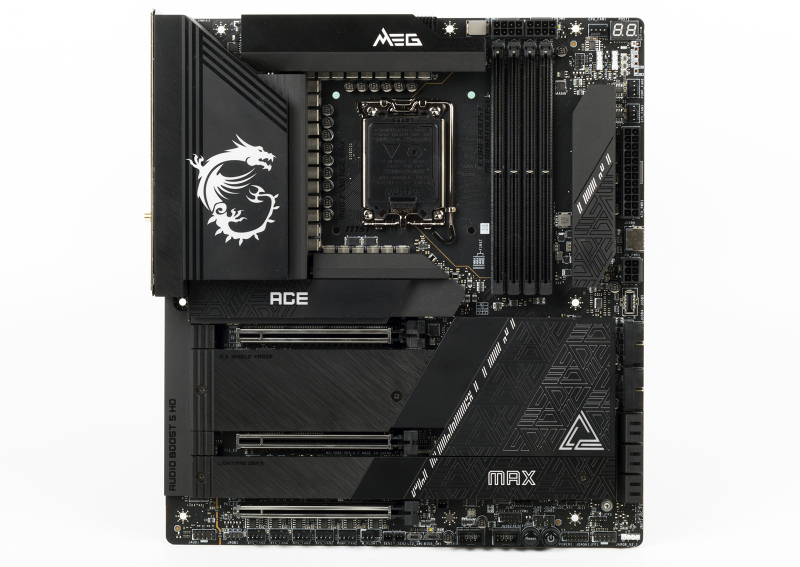
MSI MEG Z790 ACE MAX
E-ATX sounds menacing. Something like the BFG-9000 cannon in the DOOM games. In fact, the functionality and technical capabilities of the device are mainly determined by the platform and chipset. Thus, the MEG Z790 ACE MAX PCB has four DIMM slots and three PCI Express slots – when assembling a gaming PC, we rely on these indicators. The dimensions of the board allow you not to worry about many things – for example, over the choice of a processor cooling system. Even the brand new Noctua NH-D15 G2 will easily fit in the near-socket space of the motherboard without blocking the main PEG port or bending the radiators of the VRM circuit cooling system.


We will definitely evaluate the efficiency of the MEG Z790 ACE MAX radiators. In the meantime, I’ll note that the device is equipped with RGB backlighting. The dragon logo, “ACE” on the SSD heatsink, and the intricate pattern on the chipset heatsink all shine here. If desired, you can connect various LED strips to the board; there are plenty of connectors on the PCB. One connector is intended for non-addressable RGB strips and three for addressable ones. I’ll express another thought: on the basis of the MEG Z790 ACE MAX it’s easy to assemble the most beautiful, graceful assembly in the Zero RGB style.
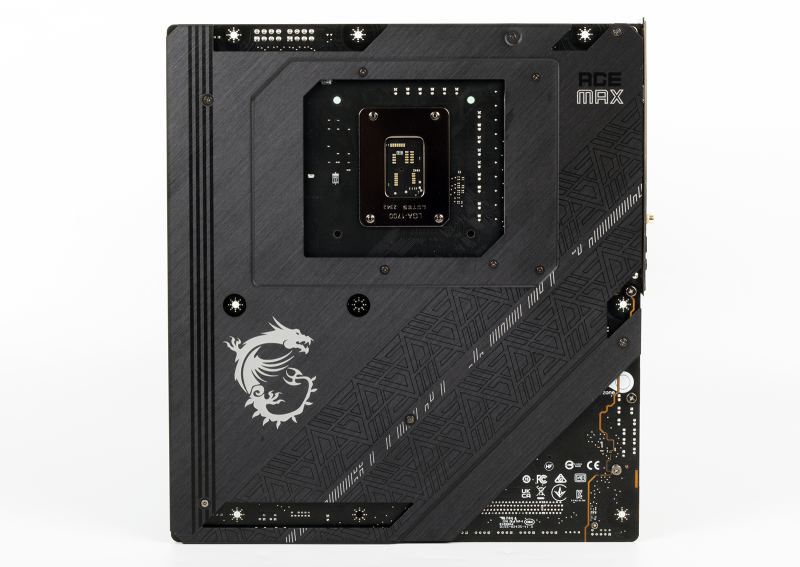
The device is based on an 8-layer printed circuit board. The device is additionally reinforced with a metal backplate. As a result, the weight of the MEG Z790 ACE MAX exceeds 2 kilograms! The back plate not only increases the rigidity of the PCB, but also additionally (from the pin side) cools the elements of the power converter. For this purpose, high-quality thermal pads with a thermal conductivity of 7 W/(m K) are used.


In my opinion, for an E-ATX form factor board, three expansion slots are… a lot. In addition, we are dealing with a mainstream LGA1700 platform, in which, when using all PCI Express ports, line dividers are certainly enabled. Thus, the main PEG connector is connected to the central processor and operates in PCI Express x16 5.0 mode. As soon as we occupy both expansion slots with discrete boards, the x16+x0 scheme turns into x8+x8. It is better to install the same GeForce RTX 4090 in a port with sixteen lines, and for some GeForce RTX 4070, in most cases, eight PCI Express 4.0 lines will be enough. And the PEG connectors connected to the processor share lines with the M.2_4 port, intended for installing an SSD. In this configuration, PCI_E1 will operate in x8 mode, and PCI_E2 will simply be disabled.
Graphics card arrays have not been used in gaming builds for a long time. So it turns out that a pair of PCI Express x16 slots is enough for the MEG Z790 ACE MAX. The third port is connected to the chipset and operates in x4 4.0 mode. All connectors are reinforced, which will not be superfluous in the era of two-kilogram video cards. The manufacturer claims that the improved PCI Express slots operate with less interference and electrical noise.
The DIMM slots are also reinforced. I’ve seen users for whom installing RAM on a motherboard is like an invitation to an arm wrestling match.
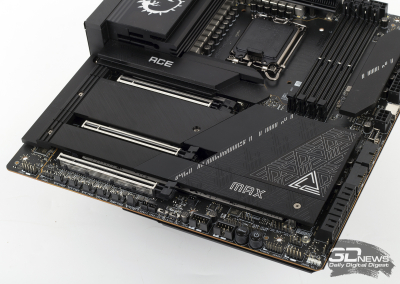
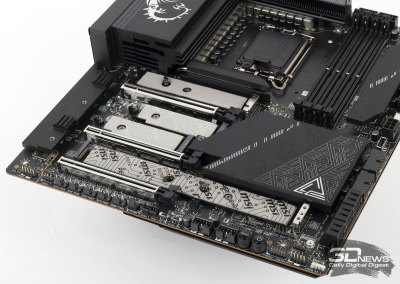
The disk subsystem of the MEG Z790 ACE MAX looks like this: the board received five M.2 slots at once (actually more, but now we are talking exclusively about free ports for SSD) and six SATA 6 Gb/s connectors – their features and capabilities are described in table at the beginning of the article. Port M2_5 in SATA 6 Gbps mode disables the SATA 7 connector. SATA A1 and SATA A2 connectors do not support RAID functionality.

Something interesting: after reading the MEG Z790 GODLIKE review and getting acquainted with the MEG Z790 ACE MAX, it may seem that the latter board actually has more M.2 slots. In fact, the metal plug attached to the right of the DIMM ports plays a purely decorative role – no connectors are hidden under it. Unlike the “god-like” board.

Interesting thing – 2: the heatsink for the M2_1 slot is equipped with a simple mechanical lock – you don’t need a screwdriver to remove it. The RGB lighting is connected to the radiator using a proprietary connector – there will be no fuss with connecting wires!

MEG Z790 ACE MAX is equipped with nine ports for connecting various fans. Eight of them are four-pin, most of the connectors are located at the bottom of the printed circuit board. The three-pin connector is the so-called W_FLOW1, which is necessary to connect the LSS refrigerant flow rate sensor.
On the one hand, eight fan connectors are a lot. Taking into account modern cable management, as well as the use of additional adapters and splitters, you must try very hard to occupy all eight connectors. MEG Z790 ACE MAX is equipped with two connectors for LSS pumps. One is soldered at the top, the other at the bottom. No matter what type of water supply you choose (maintenance-free or custom), assembling the system will be convenient and easy. On the other hand, the board could definitely use one more connector – in the area of the top M.2 slot. In tower cases, a fan mounted on the rear wall is connected to it.



In general, the hero of the review is replete with jumpers, switches, buttons, indicators and other useful elements. Some of them are unlikely to be useful to the owner of the board – they are used by a narrow circle of people, such as professional overclockers. Without others, I personally cannot imagine using the modern system. The third ones are very useful in testing, the fourth ones you use a couple of times at most, but each time their presence makes life much easier and saves nerves. I will list what immediately caught my eye when I first met the MEG Z790 ACE MAX:
- The device received external power and reset buttons.
- The board is equipped with a jumper LN2, which activates heating of the space around the socket.
- There are jumpers JLN1 and JLN2, which enable a guaranteed stable processor frequency for booting the system (helps if you have overclocked the CPU so much that you ultimately cannot even boot the BIOS).
- Jumper JOC_RT1 enables the OC Retry function – the system changes overclocking parameters until it boots successfully.
- Closing jumper JSLOW1 forces the BIOS to load during extreme CPU overclocking.
- Jumper JOC_FS1 activates the system boot with default settings.
- The EZ indicator strip displays the current stage of hardware initialization – debugging the CPU, RAM, video card, or loading the OS from the drive.
- The POST code indicator is in place.
- The I/O panel has a BIOS reset key and a button to enable the Flash BIOS function, which allows you to update the board’s firmware even without a central processor installed in it.
- There is also a Smart Button on which you can assign one of four functions: turning on/off the backlight, rebooting (with “safe” or normal settings) and turning on maximum fan speed. By the way, the connector of the standard Reset button is configured in the same way.
- There are two BIOS chips on the board, and you can switch between them using the BIOS_SW1 lever.
- The LED_SW1 slider is used to turn on/off all indicators.
- V-Check Points connectors allow you to measure parameters such as VCC, CPU_AUX and CPU_VDD2 in real time with a multimeter.
- The thermocouples included in the kit are connected to the T_SEN blocks.
- The processor socket has a through hole for connecting a thermocouple.
- In total, the motherboard is equipped with eight temperature sensors: PCH, MOS, System, CPU Socket, PCIE_1, PCIE_2 and M.2_1.

I know that you will definitely use case-mounted USB connectors. The board has two USB 3.2 Gen2x2 ports. Next to them is a 6-pin power connector PD_PWR1. It is necessary to supply additional power and enable the fast charging function. 60 W are supplied to each USB connector.
The board has “regular” internal USB 2.0 A-type and USB 3.2 Gen1 A-type connectors – two for each standard.
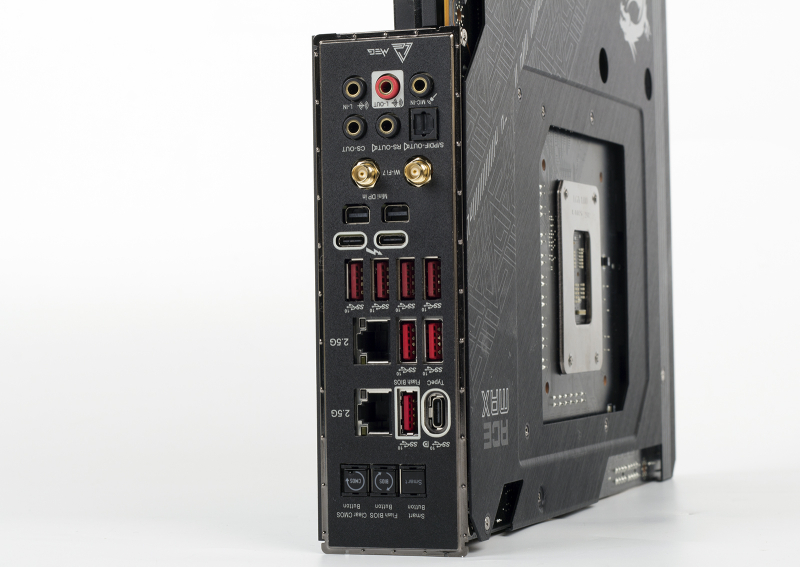
A list of all connectors available on the I/O panel of the board is given in the table. “Oh, the box is full…” – there are seven USB ports alone with a bandwidth of 10 Gbit/s. Among the other connectors, of course, a couple of Thunderbolt 4 stand out. The throughput of each such port is 40 Gbps – they are controlled by the Intel JHL8540 controller, soldered on a separate M.2 board. Next to Thunderbolt 4 there is a pair of mini-DisplayPort connectors that work to receive the signal. And the MEG Z790 ACE MAX is equipped with two 2.5-gigabit Intel I225-V controllers.
The device’s built-in audio is based on the Realtek ALC4082 codec, which provides signal resolution up to 32-bit and 384 kHz. The circuit includes an ESS ES9280AQ DAC, an oscillator and special Nichicon capacitors. Each channel of the audio subsystem is distributed across different PCB layers so that they do not interfere with each other.
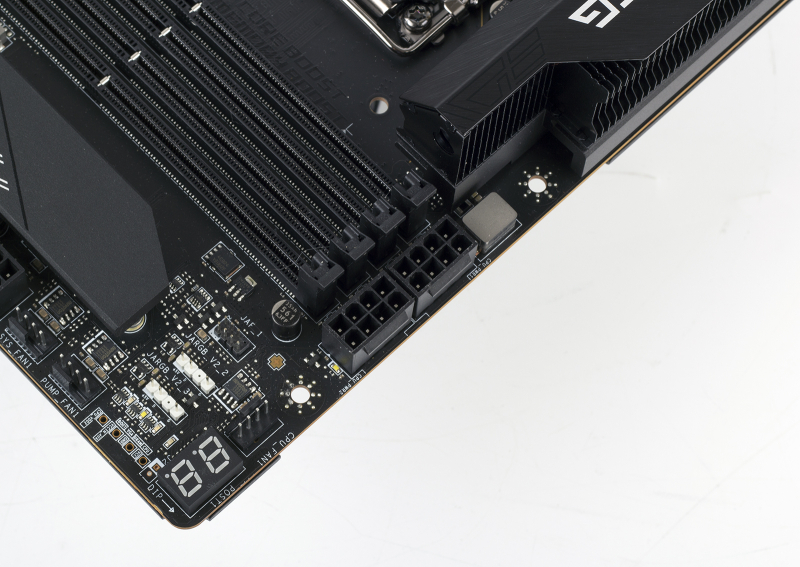
I think you noticed that the 8-pin EPS12V power connectors are soldered closer to the right edge of the PCB, rather than the I/O panel. Apparently, we owe this reshuffle to the device’s non-standard power converter – a giant VRM circuit responsible for the operation of Core central processors.
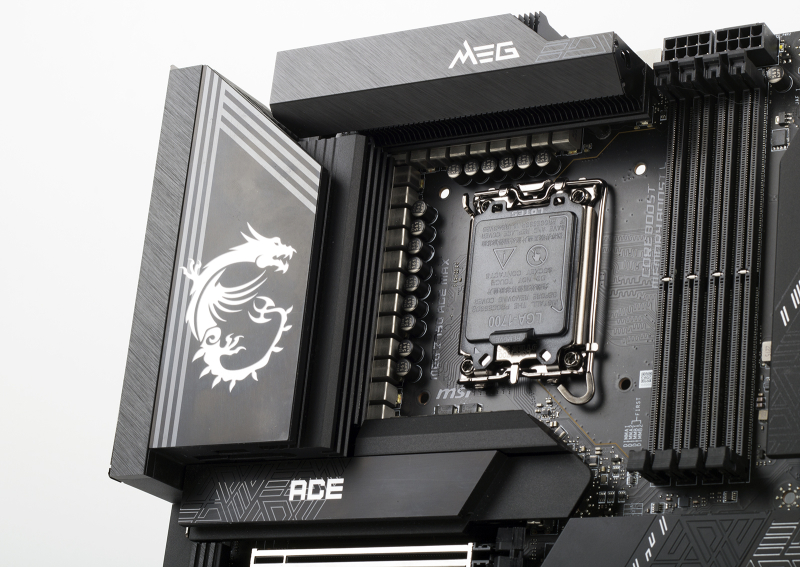
The MEG Z790 ACE MAX power subsystem operates according to a 24+2+1 scheme for VCore, VCCIO and VGT voltages. There are so many phases that we had to arrange them in a U-shaped row. Each channel has a superferrite choke and a RAA 22010540 power stage from Renesas. One such mosfet can withstand a load of 105 A. The VCore phases are controlled by the RAA229131 PWM controller from the same Renesas company. I didn’t find any doublers on the back. This means that the actual operating diagram of the MEG Z790 ACE MAX power converter corresponds to the formula 12+2+1 – some elements in the circuit are connected in parallel. The two channels of the VCCIO block are controlled by an MP2940A PWM controller from Monolithic Power Systems. MP87670 power assemblies rated at 70 A each are used here. Finally, power to the processor’s integrated graphics is controlled by a RAA 220075R0 (75 A) field-effect transistor.
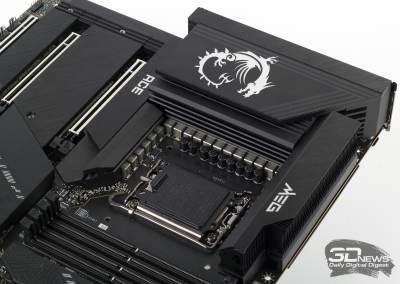
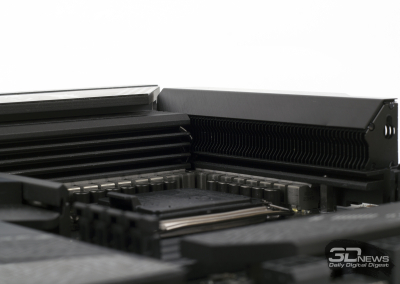
Previously, we found out that the motherboard backplate is also part of the power converter cooling system. The main load is borne by a rather ornate passive cooler, consisting of three radiator blocks and two heat pipes – just like the MEG Z790 GODLIKE.
⇡#Stand and testing methodology
To test the MSI MEG Z790 ACE MAX, we assembled a fairly powerful gaming PC. A list of all components used in the assembly is given in the table below.
The processor and power subsystem of the motherboards were loaded with Prime95 30.8 (Small FFTs subtest) and CINEBENCH R23 programs. Practice shows that among professional software there are working applications that can load Core chips to a consumption level of over 200 W, and therefore stable operation of the computer in such programs is a guarantee that the system will not subsequently overheat, throttle, or become unstable.
The stands used maintenance-free life support system Fractal Design. It turns out that the power converters of the motherboards were not additionally cooled during testing. It is also worth remembering that in real life, any of the tested motherboards will be installed in a computer case, and depending on the environmental conditions, the presented results may either improve or worsen. The use of LSS in the test bench is an attempt to determine the criteria for stable operation of the board in any situation.
The room temperature during testing was 30 degrees Celsius.
Testing was carried out in the following applications:
- 3DMark Professional Edition 2.25.8043. Testing in Time Spy and Fire Strike scenes (CPU test).
- CINEBENCH R23. Measuring the performance of photorealistic 3D rendering in the animation package CINEMA 4D, CPU test. The tables and graphs show the average integer value obtained after five test runs.
And games:
- Counter-Strike 2. DirectX 11. Dust II map. Maximum quality, upscaling – off.
- PUBG: BATTLEGROUNDS. DirectX 11. Training base. Maximum quality, resolution scale – 100%.
- Dota 2. DirectX 11. Match recording. Maximum quality, upscaling – off.
- GTA V. DirectX 11. Built-in benchmark (last scene). Maximum quality, FXAA + 4x MSAA, additional quality settings – on, 16x AF, image resolution scale – off.
- The Witcher 3: Wild Hunt – Complete Edition. DirectX 12. Novigrad and surroundings. Graphics quality “Extraordinary+”, RT – off, TAAU, NVIDIA HairWorks – max., dynamic resolution – off, upscaling – off.
- Cyberpunk 2077. DirectX 12. City ride. Quality mode is “Impressive”, textures are “High”, reflection quality is “Incredible”, RT is off, upscaling is off.
- Baldur’s Gate III. DirectX 11. Walk through Baldur’s Gate. Overall graphics quality – “Ultra”, upscaling – off, 16x AF, TAA.
Gaming performance was determined using the well-known CapFrameX program. It allows you to get the rendering time of each frame. The use of the 1st percentile instead of the minimum number of frames per second indicators is due to the desire to clear the results from random performance spikes that were triggered by reasons not directly related to the operation of the main components of the platform.
⇡#BIOS
MSI MEG Z790 ACE MAX, MAG Z790 TOMAHAWK MAX WIFI, MEG Z790 GODLIKE and MPG Z790 EDGE TI MAX WIFI are all boards with the “top” prefix. It is not at all surprising that all MSI motherboards are equipped with similar firmware, allowing you to carefully configure the central processor and system memory. The BIOS of MSI motherboards for the LGA1700 platform has been studied in detail. I don’t see the point in once again talking in detail about all the features of the Click BIOS 5 shell.
At the time of writing, the firmware called E7D86IMS.A43 was considered the current and completely stable version. It became publicly available at the end of June and was in Beta version. Since the release of the MEG Z790 ACE MAX, the manufacturer has released eight firmware versions. Today, the device supports all 12th, 13th and 14th generation central processors released for the LGA1700 platform.
Naturally, the motherboard offers an excellent set of voltages that can be adjusted independently. Many parameters are configured in different ways. So, we can set the VCore value by activating the Adaptive Mode, Override Mode and Offset Mode, as well as their combinations. The board allows you to define different consumption limits for the processor, both manually and automatically, depending on the installed cooling system. Also, the device BIOS provides full access to the processor frequency formula depending on the load, including the ability to reduce the multiplication factor when AVX commands are activated. Finally, the VRM settings offer eight predefined levels to counteract the voltage drop across the processor as current increases. Plus, the user can independently adjust the electrical impedance coefficients of the power circuit.
A complete list of variable voltages is given in the table below.
⇡#Testing
It so happened that the testing of the MEG Z790 ACE MAX took place in the unbearable summer heat of Moscow. The temperature outside exceeded 30 degrees Celsius. It was hardly any colder in the unconditioned room. I don’t see any point in somehow lowering the temperature in the room. In the end, we are testing a progressive device, which for that kind of money should work in any conditions at any time of the year.
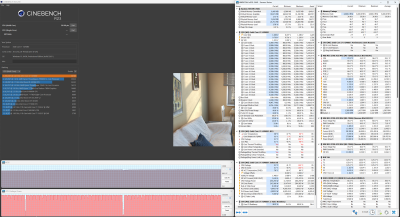
CINEBENCH R23 (nominal operation)
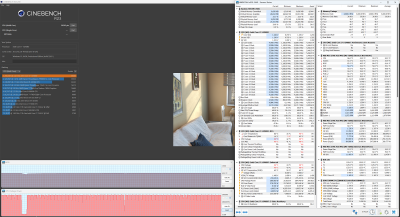
CINEBENCH R23 (nominal operating mode + additional blowing of the power converter)
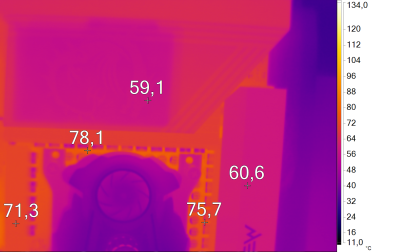
CINEBENCH R23 (nominal operation)
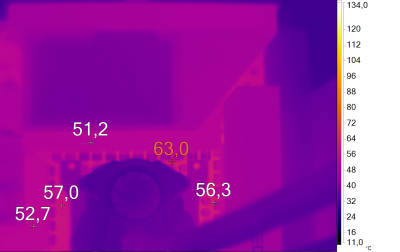
CINEBENCH R23 (nominal operating mode + additional blowing of the power converter)
The test bench used a Core i7-14700KF, which is far from the most power-hungry processor for the LGA1700 platform, but even when power limits are turned off, it consumes approximately 280-300 W. The user is required not only to choose the motherboard wisely, but also not to skimp on the cooling system.
Not every maintenance-free life support system with a 360 mm radiator is capable of discharging 300 W of energy. Especially in hot summer. Testing of the MEG Z790 ACE MAX was carried out with power limits disabled. A maintenance-free Arctic Cooling Liquid Freezer II-420 was also installed in the stand – the tiny fan blowing around the socket space was turned off.
Still, let’s focus all our attention on the capabilities of the MEG Z790 ACE MAX. We see that the board’s power converter heats up to only 80 degrees Celsius in the harshest conditions. Once again: the space around the socket of the device is not blown in any way. The motherboard is equipped with a VRM overheat protection mechanism – by default it will work when heated to 120 degrees Celsius according to the MOS sensor. If you wish, you can change this value manually in the corresponding BIOS menu of the board.
By placing a 90mm Noctua fan on the side of the motherboard (on the side of the 24-pin power connector), at a distance of 20 cm, I was able to reduce the heating of the power converter by 15+ degrees Celsius under the same conditions. In such conditions, we can safely talk about the cold VRM zone of the board. In general, we see that the MEG Z790 ACE MAX is capable of withstanding a more serious load – in case you are planning to “fence” a powerful custom liquid cooling system. There can be no doubt: the device will cope with Core i9 chips with power limits disabled. Another thing is that in a gaming system there is no urgent need for this.
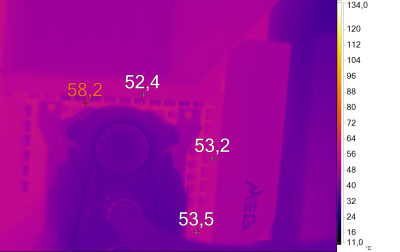
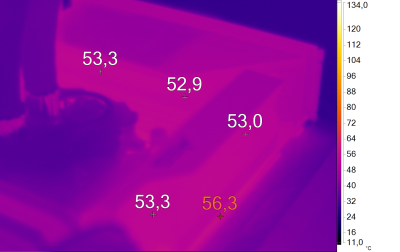
Heating of the motherboard converter (Cyberpunk 2077, the space around the socket is not blown in any way)
In games, the MEG Z790 ACE MAX power converter does not heat up at all. In combination with GeForce RTX 4090 graphics, in games at low resolutions, the power consumption of the Core i7-14700KF reaches 180-200 W, but on average it stays at 160 W. If you are building a PC only for games, then the system does not require an expensive water cooler; a high-quality supercooler can handle such loads.
Two things will allow you to further reduce the power consumption of the central processor. The first is setting a power limit. Thus, the 200 W limit makes the Core i7-14700KF slower in the same CINEBENCH R23 by 7%. There is an excellent article on this topic on our website: “Core i9-13900K and Ryzen 9 7950X on a diet: reducing consumption and temperatures.”
The second way to reduce power consumption is to manually adjust the VCore voltage. Please note that a lot depends on the processor itself. Thus, the test Core i7-14700KF is very reluctant to respond to downvolting. Stable operation of the chip is possible only when the voltage curve is reduced by -0.065 V in Offset mode. In the best case, it will be possible to “cut off” 20 W of energy.
Finally, I had no problems overclocking the RAM kit I had on hand. However, in games (even using the GeForce RTX 4090) we received an increase in frame rate that was close to the measurement error.
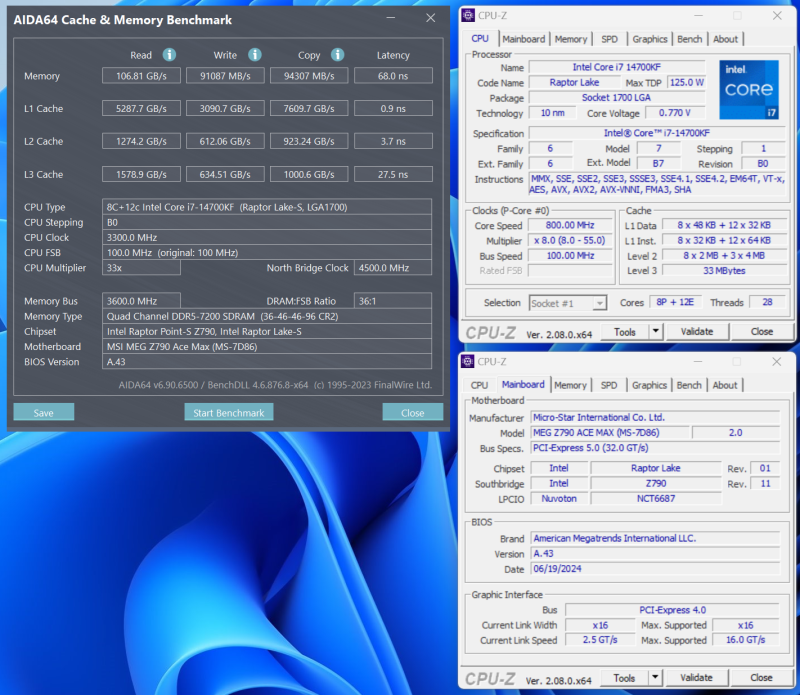
⇡#Conclusions
Boards like the MEG Z790 ACE MAX are quite difficult to evaluate. What can you complain about here? The board is modern, and its relevance will not decrease in the near future. It is suitable for assembly of any complexity and will support any existing Core processor. Testing has shown that the MEG Z790 ACE MAX is not afraid of either heat or harsh conditions of use. Making an upgrade based on such a motherboard is a pleasure. The device is equipped with five M.2 slots. Assembling a system with custom “water” is always welcome. Even without using adapters and splitters, you can connect up to eight fans to the board. Finally, MEG Z790 ACE MAX is equipped with all modern interfaces, including PCI Express 5.0 and Wi-Fi. If you don’t need them, you can save a little by purchasing a version of the device without the word “MAX” in the name.
Perhaps there is only one question left to decide: is the MEG Z790 ACE MAX worth the money, given that the LGA1700 platform is in the final stage of its life cycle? I’m afraid I won’t be able to get a definite answer.